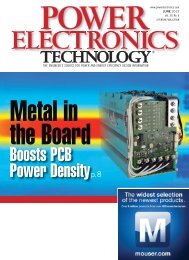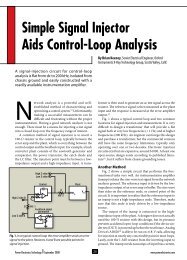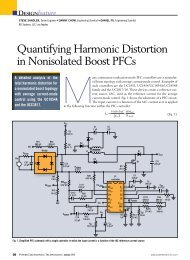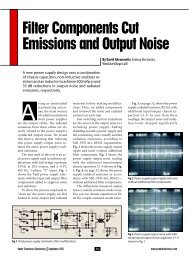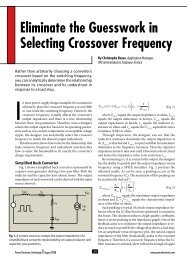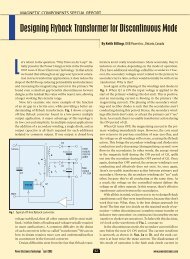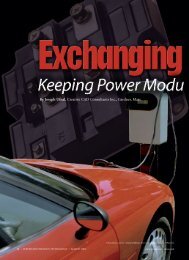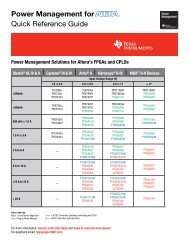Power Electronics Technology September 2004 www ...
Power Electronics Technology September 2004 www ...
Power Electronics Technology September 2004 www ...
You also want an ePaper? Increase the reach of your titles
YUMPU automatically turns print PDFs into web optimized ePapers that Google loves.
mative. “We stuck with the old concept long enough,” says<br />
Lidow. “If you talk to our engineers, they feel that the basic<br />
field effect transistor is a mature process and a mature<br />
product. But I don’t see anything new outside of better<br />
geometries, more transistors per square inch and possibly<br />
thinner silicon.”<br />
“I do feel there’s a lot of possibility in packaging,” he<br />
continues. “When you take a small piece of silicon and put<br />
a big bulk of plastic over it, that is not an effective way to<br />
package. So, there will be some changes in packaging. That<br />
will necessitate better passivation of surfaces.”<br />
Because of IR’s success with MOSFETs, the devices<br />
became commodities, affecting an evolution in the<br />
company’s mission. “With our success in field effect transistors,<br />
we pushed the world forward in technology and<br />
made this particular technology available to everybody. And<br />
that makes things possible that were not possible before.<br />
Everything is smaller, more efficient and requires less<br />
power.”<br />
As Lidow explains, the next step would be to pursue<br />
these same goals with systems, particularly in motion control<br />
and in lighting where the potential energy savings are<br />
great and where IR has traditionally sought to improve efficiency.<br />
Automotive, an area related to motion control, also<br />
presents opportunities for energy savings. For its initial<br />
foray into system-level designs, the company leveraged its<br />
LIFETIME ACHIEVEMENT AWARD<br />
experience in high voltage to develop high-voltage ICs, but<br />
from there went on to develop low-voltage components.<br />
Despite his many years in the power semiconductor industry,<br />
Lidow is still excited about his work. “I like to be in<br />
the forefront,” he explains. “It means that our company is<br />
not a ‘me-too’ company. It affected our profitability in the<br />
past because we always wanted to be first. But then, we created<br />
an industry that didn’t exist. We’re doing this now<br />
again with the DirectFET. And we’re working on alternative<br />
substrate materials, which is exciting. Also, I’m very<br />
interested in getting more electricity in the automobile. To<br />
me, this is almost a passion.” Lidow, who currently drives a<br />
leased Toyota electric car, notes that his motivation for<br />
improving automobile efficiency is the desire to diminish<br />
our dependence on foreign oil.<br />
In addition to his passion for technology, Lidow finds<br />
continued motivation in supporting the people who are<br />
responsible for IR’s success.<br />
“We recognize one thing. This is why I’m sticking<br />
around, because I want to see that this is preserved:<br />
The people are the most important ingredient of the<br />
company—not the equipment, not the real estate, not the<br />
technology. You have to realize that people are motivated<br />
differently. Don’t introduce bureaucratic things—be able<br />
to make exceptions, if necessary. To me, this is terribly<br />
important.” PETech<br />
CIRCLE 241 on Reader Service Card or freeproductinfo.net/pet<br />
<strong>www</strong>.powerelectronics.com 75<br />
<strong>Power</strong> <strong>Electronics</strong> <strong>Technology</strong> <strong>September</strong> <strong>2004</strong>




